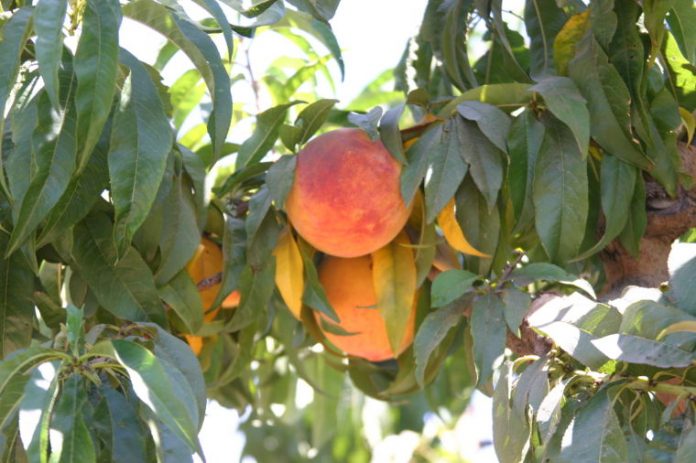The announcement this week from China that it intends to impose retaliatory tariffs on 128 U.S. products sent shock waves across U.S. agriculture, especially in California.
Among the Chinese targets are some of the biggest money crops in San Benito County and southern Santa Clara County—fruit, nuts and wine.
The Chinese announcement—not unexpected—followed the Trump administration’s decision to impose tariffs on some $50 billion worth of Chinese goods.
In its statement, China did not indicate when the tariffs would go into effect but said it would implement them in two parts. The first part would affect 120 U.S. products valued at $977 million, including fresh fruit, dried fruit, nuts and wine, with a 15 percent tariff. The second part would cover eight U.S. products worth nearly $2 billion, including pork, with a 25 percent tariff.
China said if it fails to reach an agreement with the United States, then it would place tariffs on the first part of the list.
The list of Chinese tariff targets includes:
- Dried coconut, Coconut without inner shell, Other coconut
- Unhulled and shelled Brazilian nuts, chestnuts, pistachio nuts
- Unshelled and shelled cashews, hazelnuts, walnuts, almonds
- Unhulled and roasted macademia nuts
- Betel nuts, pine nuts
- Other fresh or dried nuts
- Fresh or dried bananas, plantains, dates, figs, pineapple, avocado
- Fresh or dried guava, mango, mangosteen, orange, all other citrus, including clementines, virgin and other hybrid oranges, grapefruits, lemons, limes
- Raisins
- Fresh grapes, watermelons, cantaloupe, papayas, apples, pears, cherries, peaches, plums, prunes, nectarines, raspberry, blackberry, mulberry and loganberry, cranberry, cowberry, kiwi, persimmon, lychee, durian, rangon, lambutan, lotus, papaya, carambola, lotus fog, gambaya
- Frozen strawberries, raspberries, blackberries, mulberries, rose hips, currant and gooseberries
- Dried apricots, dates and other fruits and nuts
- All wines
- All Ginseng products
China and Hong Kong represent the third-largest export market for California agricultural products, according to the California Department of Food and Agriculture. Top agricultural exports to China and Hong Kong include pistachios, almonds, wine, oranges, dairy products and hay.
“California farmers depend on trade for a living, so we are quite concerned about the retaliation resulting from the tariffs announced,” said Sara Neagu-Reed, legislative associate for the California Farm Bureau Federation. “We would prefer to see the executive branch working to open more new markets. We are continuing to remind our trade officials of those goals.”
China is now one of the fastest growing wine markets in the world and will soon be second only to the U.S. in value, according to the Wine Institute, which said China’s proposed tariffs on U.S. wine “could have a significant negative impact on the future growth of wine exports to China.”
American Farm Bureau Federation President Zippy Duvall said in a statement that if trade continues to deteriorate, “our lives as farmers and ranchers will become more difficult.”
“Retaliation in the trade arena makes our outlook even worse,” he said.
California’s nut industry—almonds, walnuts and pistachios—sold $1.1 billion in 2016 to China, its third-largest foreign customer, according to the state Department of Food and Agriculture. China also bought more than $220 million in fresh citrus and table grapes from California that year, according to the department’s data.
The California wine industry, which has made big inroads to the Chinese market, sold about $197 million of its product there last year, according to the Wine Institute, a California advocacy organization. U.S. wine exports to China and Hong Kong (which often re-exports to the mainland) have more than quadrupled in the last decade and rose 10% last year, according to the institute.
Each of those California sectors stands to lose momentum in a worldwide competition for a share of the rapidly expanding Chinese consumer market.
San Benito County agricultural products
Here are the top agricultural products in San Benito County, as reported by Karen Overstreet, county agricultural commissioner, for 2016, the most recent year available.
- Vegetables: $267.1 million
- Fruit and Nut Crops: $49.4 million
- Field Crops: $28.6 million
- Total agricultural products in San Benito County: $367 million
- Misc. Vegetables: $55 million
- Salad Greens: $43.9 million
- All Peppers: $33 million
- Romaine Lettuce: $32.9 million
- Wine Grapes: $31.1 million
- Spinach: $25.3 million
- Kale: $19 million
- Onions/Garlic: $12.9 million
- Fruit and Nuts: $12.2 million
Santa Clara County agricultural products
Total agricultural products in Santa Clara County, for 2016, the most recent year available from state officials: $310 million
- Nursery Crops : $81.5 million
- Mushrooms: $79 million
- Bell Peppers: $19.8 million
- Spinach: $16.6 million
- Tomatoes, Fresh: $15.5 million
- Lettuce, all: $14.7 million
- Other Peppers : $10.6 million
- Corn: $9 million
- Wine Grapes: $7.6 million
- Chinese Vegetables: $6.6 million
- Garlic: $6.5 million
- Beans: $6 million
- Celery: $5.2 million
- Salad Greens: $4.2 million
- Broccoli: $2.4 million
- Tomatoes, Processed $2 million
- Cabbage: $1.9 million
- Cut Flowers: $1.8 million
- Hay, Grain: $1.1 million








